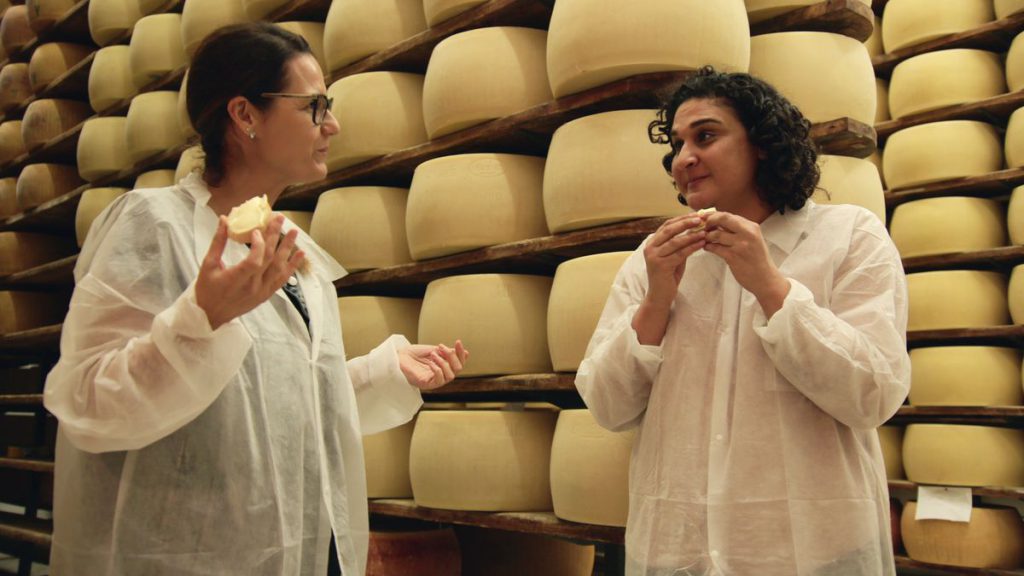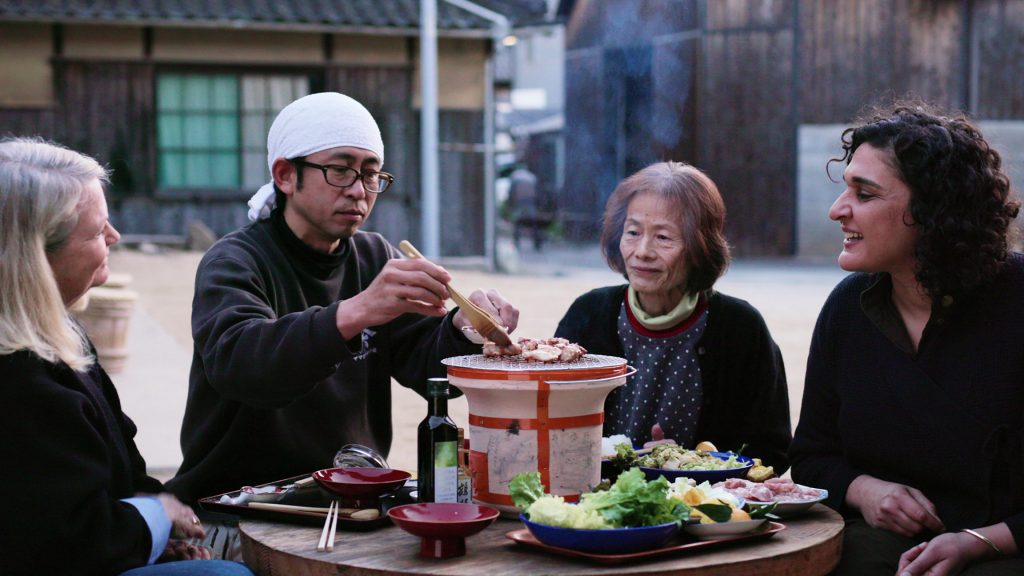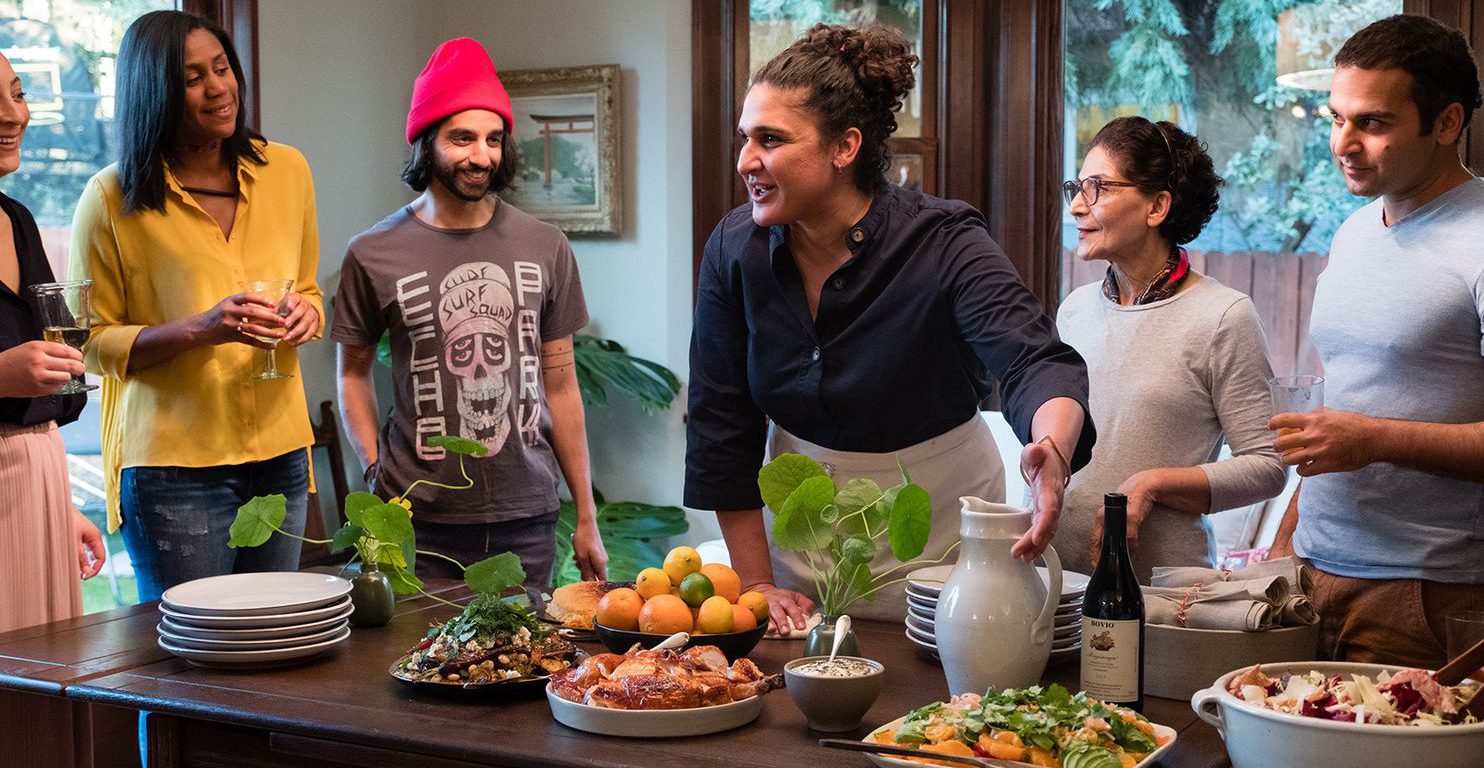Một show chỉ thuần về ẩm thực mà tụi mình tìm được. Nghe tựa đề có vẻ thú vị, các nhân tố giúp làm bùng nổ cho món ăn hay như chị đầu bếp trong chương trình nói “MASTER THESE FOUR ELEMENTS, MASTER THE KITCHEN” (Khống chế được 4 nguyên tố này, bạn sẽ làm chủ gian bếp của mình). Ngoài TV Show cùng tên, chị đầu bếp này còn xuất bản sách và có vẻ khá nổi tiếng (sau khi kết thúc show mình mới biết).
Thời lượng:
4 tập, mỗi tập nói về 1 nguyên tố cơ bản trong nấu ăn, được quay tại mỗi quốc gia khác nhau:
- Salt (muối, độ mặn): quay tại Nhật.
- Fat (chất béo): quay tại Ý.
- Acid (chua): quay tại Mexico.
- Heat (nhiệt độ) quay tại Mỹ.
Nội dung chính và cảm nhận:
Trước khi đi vào nội dung có lẽ nên giới thiệu chút về chị đầu bếp này. Samin Nosrat là đầu bếp người Mỹ gốc Iran, chị này xuất phát điểm không phải theo nghề đầu bếp, trong 1 lần ăn tại nhà hàng Chez Panisse đã khiến chị thay đổi định hướng nghề nghiệp của mình. Học nghề tại nhà hàng, theo đuổi nghề bếp, viết sách, tham gia các show về ẩm thực, và cuốn sách “Salt Fat Acid Heat” được xem là một cuốn sách ẩm thực được đánh giá cao, giành nhiều giải thưởng lớn. Show này làm dựa trên nguyên liệu chính là cuốn sách cùng tên.

Không phải ngẫu nhiên mà mỗi nguyên tố quay tại 1 quốc gia đại diện nào đó với những gia vị chính nào đó như:
- Tập Fat thì đại diện là phô mai, quay tại Ý. Mình thấy Pháp cũng nổi tiếng về phô mai, không chắc là nếu mở cuộc bình chọn về phô mai giữa 2 quốc gia này thì quốc gia nào sẽ thắng thế? Với mình thì mình thường coi việc chế biến phô mai ở Ý hơn, nhìn mấy khối phô mai ở Ý với mình cũng dễ nảy ra ham muốn lấy 1 khối về hoặc ngồi thèm thuồng chảy nước miếng.
- Tập Salt đại diện là dashi, miso… quay tại Nhật. Khi coi đến tập này biết quốc gia được lựa chọn là Nhật, mình cũng không bất ngờ về các thành phần trong tập này. Thậm chí vị umami (gốc từ Nhật) đã trở thành một vị cơ bản để diễn tả “vị ngon”, đặc biệt khi bạn ăn mì ramen, ăn cái gì đậm đà người ta hay thốt lên “umami” :D.
- Tập Acid thì nguyên liệu lại là các loại trái cây chua như cam, chanh, quay tại Mexico (đất nước với món ăn có vị đặc trưng về chua và cay, mình thấy khoản này có vẻ giống Thái, nhưng nói về vị trí trên bản đồ ẩm thực, chắc Thái không thể địch lại Mexico)
- Tập Heat quay tại Mỹ, tại nhà hàng nơi chị học nghề và làm việc. Về việc chọn quốc gia cho nguyên tố cuối có vẻ khá là chủ quan nhưng biết sao được, đối với quan điểm của chị đầu bếp là như vậy, và mình nghĩ thường nhà hàng đầu tiên, nhà hàng nơi mình học nghề và làm việc tất nhiên sẽ để lại ấn tượng nhất định trong người đó, nên có thể hiểu được.

Lần đầu tiên khi mình coi show này, mình đã nghĩ bâng quơ khá nhiều, tự đặt lại câu hỏi sao lại chỉ chọn 4 nguyên tố này, thật sự khi mình nếm 1 món ăn nào đó, liệu vị làm mình cảm thấy 1 món ăn thật sự bùng nổ, thật sự đặc biệt đều liên quan đến 4 yếu tố này không? Sao lại không phải ngọt, cay, người ta hay nói ăn cay giúp kích thích khẩu vị, nhưng sau khi ngẫm nghĩ lại thì thấy việc chọn 4 nguyên tố này đúng là có lý do của nó và rất hợp lý. Ở cuối mỗi tập là phần nấu ăn của chị này, là việc đúc kết kinh nghiệm, kiến thức ở những quốc gia đó để tạo nên 1 bàn tiệc vừa mang phong cách của chỉ, vừa có dấu ấn của nguyên liệu của quốc gia, mặc dù không phải món nào mình cũng cảm thấy ngon, nhưng khá là thú vị. Tuy nhiên, có tập ở Nhật là chỉ không phải bếp chính, chỉ là người phụ thôi, người thưởng thức thôi, cũng không hiểu sao, cũng có thể xem Nhật là 1 quốc gia với phong cách sử dụng gia vị và nấu ăn đặc biệt chăng?
Cám ơn mọi người đã đọc bài viết. Mình xin khép lại bài review cho show này tại đây. Chúc mọi người thưởng thức show này vui vẻ và để lại vài cảm nhận cho mình nếu đã từng coi show này nhé.
Usagi
*Ảnh từ internet


how long has semaglutide been on the market: rybelsus patent expiration – Semaglu Pharm
Outsourcing accounting services allows companies https://newsomsk.ru/news/62271-professionalne_buxgalterskie_uslugi_pochuvstvuyte_/amp/
Сто процентов хороший материал сайта…
Какие потолки лучше натяжные или из гипсокартона?
Оставляйте свое мнение!
Outsourcing accounting services allows companies http://www.mosoblpress.ru/42/201730/
Lipi Pharm: Lipi Pharm – Lipi Pharm
Good post. I learn something totally new and challenging on sites I
stumbleupon every day. It’s always exciting to read through content from
other writers and practice a little something from their websites.
Lipi Pharm Cheap Lipitor 10mg / 20mg / 40mg п»їBuy Lipitor without prescription USA
rybelsus weight loss pills: rybelsus glp1 – how long does semaglutide take to work
Tree-covered mountains rise behind a pile of trash, children run through the orange haze of a dust storm, and a billboard standing on parched earth indicates where the seashore used to be before desertification took hold. These striking images, exhibited as part of the Right Here, Right Now Global Climate Summit, show the devastating effects of climate change.
kra34 cc
The summit, held at the University of Oxford in the UK and supported by UN Human Rights (OHCHR), aims to reframe climate change as a human rights crisis and spotlight climate solutions. It works with everyone from policymakers to artists to get the message across.
“Photographers document the human rights impacts of climate change, helping to inform the public and hold governments and businesses accountable,” said Volker Turk, UN High Commissioner for the OHCHR, via email. “The Right Here, Right Now Global Climate Summit shows the power of collective action — uniting storytellers, scientists, indigenous leaders, and others to advance climate solutions rooted in human rights.”
Coinciding with World Environment Day on June 5, the exhibition — titled “Photography 4 Humanity: A Lens on Climate Justice” — features the work of 31 photographers from across the globe, all documenting the effects of global warming and environmental pollution on their own communities.
Climate change disproportionately affects vulnerable populations around the world. Despite emitting far fewer greenhouse gases, low-income nations are suffering the most from extreme weather events and have fewer resources to adapt or recover.
Photographs at the exhibition show the effects of desertification, flooding and plastic pollution. A black and white image shows the ruins of a house in West Bengal, India, sloping towards the Ganges River, with the owner sitting alongside. Riverbank erosion is degrading the environment and displacing communities in the area. Photographer Masood Sarwer said in a press release that the photo depicts the “slow violence” of climate change: “These are not sudden disasters, but slow-moving, relentless ones — shaping a new category of environmental refugees.”
Another photo, taken by Aung Chan Thar, shows children fishing for trash in Inle Lake, Myanmar. The lake was once a pristine natural wonder but now faces the growing threat of plastic pollution. “This image of children cleaning the water symbolizes the importance of education and collective action in preserving our environment for a sustainable future,” he said.
Organizers hope that the exhibition will help to humanize the climate crisis. “Our mission is to inspire new perspectives through photography,” said Pauline Benthede, global vice president of artistic direction and exhibitions at Fotografiska, the museum of photography, art and culture that is curating the exhibition at the summit. “It draws attention to the human rights issue at the heart of global warming, which affects both the world’s landscapes and the people that live within them.”
“Photography is the most influential and inclusive art form of our times and has the power to foster understanding and inspire action,” she added.
does medicaid cover rybelsus Order Rybelsus discreetly SemagluPharm
LipiPharm: Lipi Pharm – п»їBuy Lipitor without prescription USA
http://prednipharm.com/# PredniPharm
Tree-covered mountains rise behind a pile of trash, children run through the orange haze of a dust storm, and a billboard standing on parched earth indicates where the seashore used to be before desertification took hold. These striking images, exhibited as part of the Right Here, Right Now Global Climate Summit, show the devastating effects of climate change.
Площадка кракен
The summit, held at the University of Oxford in the UK and supported by UN Human Rights (OHCHR), aims to reframe climate change as a human rights crisis and spotlight climate solutions. It works with everyone from policymakers to artists to get the message across.
“Photographers document the human rights impacts of climate change, helping to inform the public and hold governments and businesses accountable,” said Volker Turk, UN High Commissioner for the OHCHR, via email. “The Right Here, Right Now Global Climate Summit shows the power of collective action — uniting storytellers, scientists, indigenous leaders, and others to advance climate solutions rooted in human rights.”
Coinciding with World Environment Day on June 5, the exhibition — titled “Photography 4 Humanity: A Lens on Climate Justice” — features the work of 31 photographers from across the globe, all documenting the effects of global warming and environmental pollution on their own communities.
Climate change disproportionately affects vulnerable populations around the world. Despite emitting far fewer greenhouse gases, low-income nations are suffering the most from extreme weather events and have fewer resources to adapt or recover.
Photographs at the exhibition show the effects of desertification, flooding and plastic pollution. A black and white image shows the ruins of a house in West Bengal, India, sloping towards the Ganges River, with the owner sitting alongside. Riverbank erosion is degrading the environment and displacing communities in the area. Photographer Masood Sarwer said in a press release that the photo depicts the “slow violence” of climate change: “These are not sudden disasters, but slow-moving, relentless ones — shaping a new category of environmental refugees.”
Another photo, taken by Aung Chan Thar, shows children fishing for trash in Inle Lake, Myanmar. The lake was once a pristine natural wonder but now faces the growing threat of plastic pollution. “This image of children cleaning the water symbolizes the importance of education and collective action in preserving our environment for a sustainable future,” he said.
Organizers hope that the exhibition will help to humanize the climate crisis. “Our mission is to inspire new perspectives through photography,” said Pauline Benthede, global vice president of artistic direction and exhibitions at Fotografiska, the museum of photography, art and culture that is curating the exhibition at the summit. “It draws attention to the human rights issue at the heart of global warming, which affects both the world’s landscapes and the people that live within them.”
“Photography is the most influential and inclusive art form of our times and has the power to foster understanding and inspire action,” she added.
Гражданство по рождению, натурализации и инвестициям — сравниваем страны, сроки и требования https://vgrazhdanstve.ru/
Predni Pharm: PredniPharm – where to buy prednisone in canada
rosuvastatin/ezetimibe 40/10 mg: Crestor Pharm – does crestor cause dry mouth
Crestor Pharm [url=http://crestorpharm.com/#]Safe online pharmacy for Crestor[/url] rosuvastatin tabs
LipiPharm: atorvastatin and belly fat – Lipi Pharm
1xBet — это одна из самых популярных и надежных платформ, которая предлагает уникальные возможности и привлекательные бонусы для своих пользователей. Независимо от того, являетесь ли вы новичком в мире ставок или опытным игроком, промокоды 1xBet — это отличный способ повысить свои шансы на выигрыш.
1хбет проверка промокода это особая комбинация символов и цифр на бонус до 32 500 рублей. Действует это предложение только для новых игроков и после регистрации они получают 130% от суммы пополнения первого депозита.
Использование промокодов 1xBet имеет множество преимуществ. Они позволяют вам получить дополнительные средства для ставок, что дает вам больше возможностей для выигрыша. Бонусы, полученные с использованием промокодов, могут быть использованы для различных видов ставок на спорт, казино, покер и другие игры, предлагаемые 1xBet. Таким образом, вы можете наслаждаться игрой и одновременно увеличивать свои шансы на успех.
https://lipipharm.com/# LipiPharm